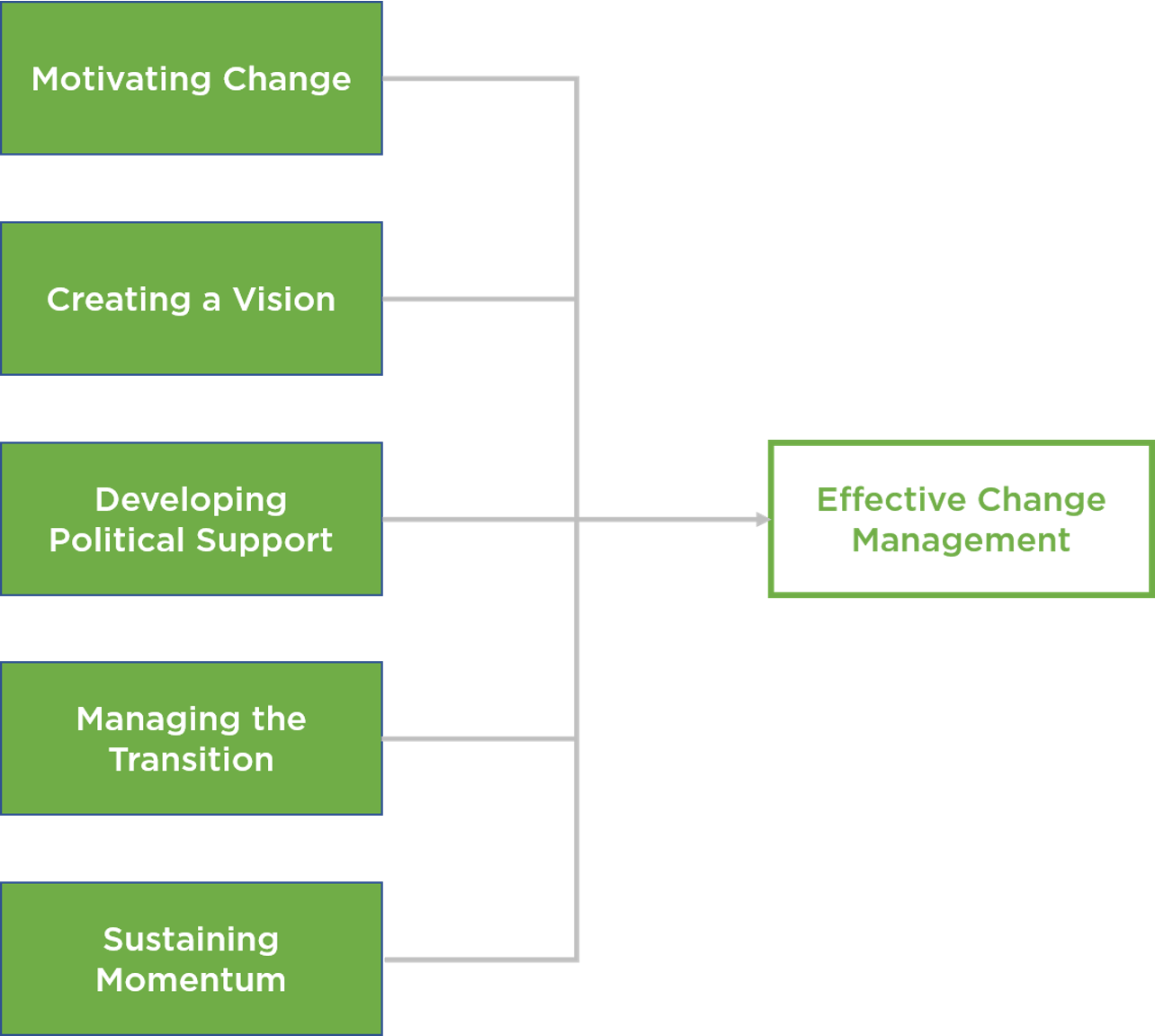
Five Activities to Effectively Lead and Manage Change
This content was previously published by Campus Labs, now part of Anthology. Product and/or solution names may have changed.
Changes can vary in complexity—from simple processes to intricate transformations. As higher education seeks to address the forces of change triggering significant shifts in operations, institutions are considering new and possibly radical ways to strengthen their efficiencies. To ensure that actions taken are effective, institutional leaders should implement several key activities associated with successfully leading and managing organizational changes.
According to Cummings and Worley (2009), the diversity of practical advice for leading and managing change can be organized into five major activities: 1) motivating change; 2) creating vision; 3) developing political support; 4) managing the transition; and 5) sustaining momentum. Each activity provides general guidelines for effective change management well as represents a key element in change leadership. An institution should identify a model that includes the priorities and areas of emphasis described in these five activities of change to improve their organizational effectiveness and performance.

Adapted from “Organization Development & Change,” by T. G. Cummings and C. G. Worley, 2009, p. 164. Copyright 2009 by South-Western, a part of Cengage Learning.
Motivating Change
The first activity includes creating a readiness for change and developing approaches to overcome resistance. Organization members generally do not support change unless compelling reasons convince them otherwise. Therefore, leadership must educate the campus community about the need for change, disclose the institution’s current status and where it needs to be in the future, and convey realistic expectations about how change might be accomplished.
Institutional leaders should also recognize that people are likely to resist change for a variety of reasons, including fear of the unknown or whether their current skills will be valued in the future. Leaders should listen and learn how people are experiencing change by extending empathy and support to address resistance. People need to feel that their concerns are being heard. Finally, leaders must involve individuals directly in planning and implementing change because people need to feel that the approach to change includes their input and involvement.
Creating a Vision
The second activity involves creating a vision of what the campus community wants the institution to look like or become. Leaders must express a clear vision that provides a purpose and reason, describes the desired future state, and energizes commitment from the organization's people. Moreover, it is critically important that organization members believe that the vision is relevant and realistic. Research indicates that compelling visions must do two key things:
- Describe the core ideology of an institution (i.e., the motivation that brings people to work each day and gives work meaning)
- Construct an envisioned future that vividly reflects the specific change being considered
Developing Political Support
Matters of power and politics are critically important to recognize and manage during organizational change activities. Attempts to change an organization often threaten the balance of power among individuals and groups, resulting in political conflicts. For success, the change effort must leverage all key power players who are recognized as having strong expertise, influence and integrity.
In managing the political dynamics of change, the first task is to evaluate the change agent’s sources of power to determine how to influence others in support of changes as well as to detect areas that need to be strengthened. Second, change agents should identify key stakeholders such as faculty, staff and administrators with interest in the changes. And the third task involves using power to influence stakeholders and motivate a critical mass for change.
Managing Transition
This activity involves moving from an existing state to a desired future state—such movement requires a transition period of actions to help implement the conditions needed to reach the desired future. Three major tasks aid in the facilitation of the transition: activity planning, commitment planning and change management structures. Activity planning provides a roadmap of the specific activities and events that must occur during the transition period for the change to be successful. It should include discrete tasks and remain flexible for regular feedback.
For commitment planning, specific plans for identifying key stakeholders and obtaining their commitment to change throughout the transition process is needed. Finally, special structures for managing the change process during the transition need to be created to help maintain clear and explicit direction.
Sustaining Momentum
The final activity is often the most difficult in leading and managing change. Over time, the excitement of change dissipates, and campus members return to old behaviors and processes. Explicit attention must be paid by institutional leaders to sustain the momentum of the implementation and adjustment of plans. This includes providing financial and human resources for the changes, creating a support system for change agents, developing opportunities for organizational members to build new knowledge and skills, reinforcing the new behaviors required to implement changes, and staying the course through full implementation.
Each of these activities is important for leading and managing change. Without motivation and commitment, getting movement from individuals on the desired change will be difficult. Without a vision, change will be disorganized and diffuse. Without the support of power players, change may be blocked or even sabotaged. Without a transition process, the institution will have difficulty operating while moving to its future state. And without sustaining momentum, the institution will not be able to manage the changes to completion. Therefore, institutional leaders must give care, attention and effort to each activity when planning and implementing change.
